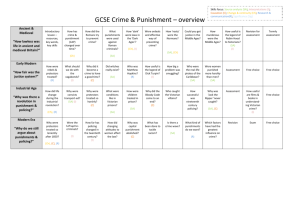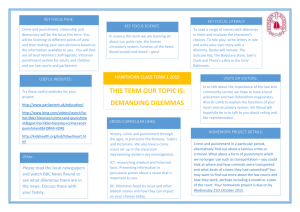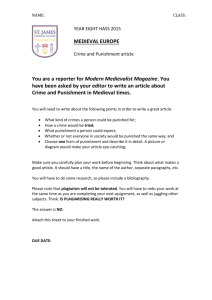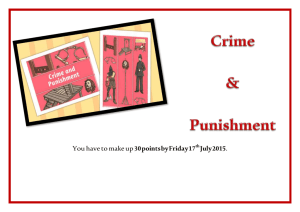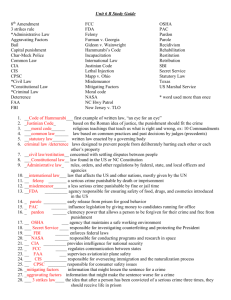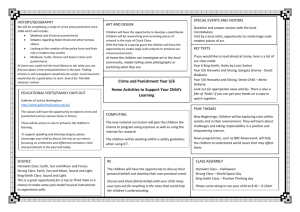Course outline
advertisement
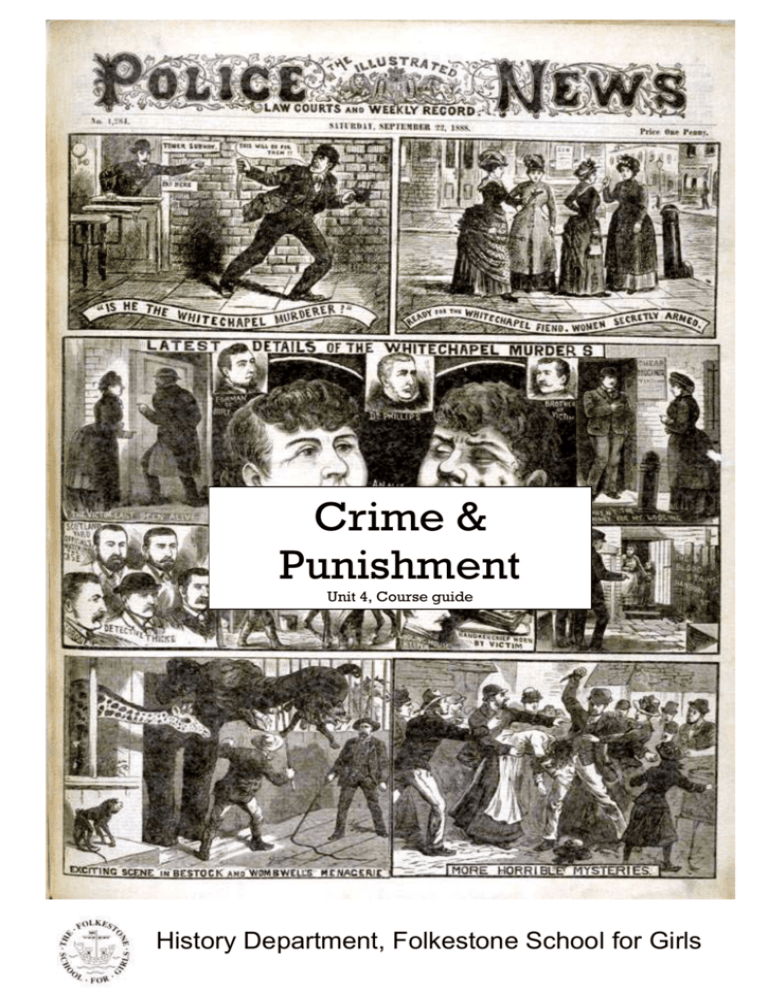
Crime & Punishment Unit 4, Course guide History Department, Folkestone School for Girls Unit 4, Crime & Punishment in Britain, c.18301965 Course weighting Unit / Title Unit 1 Historical Themes in Breadth (Russia & USA) Unit 2 British History Depth Study (Changing Role of Women) Unit 3 Depth Study & Associated Controversy (Cold War) Unit 4 Historical Enquiry (Crime and Punishment) Weighting 25% 25% 30% 20% Topic areas The impact of industrialisation on the crime rate in the early 19 th century and on the crimes committed Changes in policing The successes and failures of different forms of prison for men, women and juveniles The changing approaches to punishment and law enforcement over the period Structure of the course Part A (Depth Enquiry) An in-depth enquiry into the short-term significance (i.e. up to twenty years) of a key institution, individual case or factor within the period you have studied. You will explore and evaluate a range of sources that are contemporary to the period, along with relevant secondary sources. Part B (Breadth Enquiry) You will explore the impact of factors within a broader context, for example the effects of industrialisation on crime and punishment between c.1830 and 1965. You hopefully will be able to demonstrate your ability to conduct an enquiry by showing your independent use of reading, using a wide variety of resources. This section does not require you to evaluate any source material. Examples: Part A: What impact did the case of the Tolpuddle Martyrs / Christopher Craig and Derek Bentley have on attitudes towards crime and punishment in the short-term? Part B: Assess the significance of individual cases in changing attitudes towards crime and punishment in the years c.1830-1965 The maximum word length for your coursework is 4000 words, and you should write roughly 2000 words for each question. There are strict guidelines on the amount of direction teachers can provide, for example they are not allowed to mark draft versions of your final coursework. The emphasis is on independent study and your ability to explore individual pathways of research. Grade boundaries Unit grade Total possible mark 50 A* 92% A 84% B 72% C 62% D 52% Coursework requirements You must include a bibliography with your work – your teacher will give you guidance on how to set this out, but follow the same format as the bibliography in this guide Bibliography Crime and punishment is a popular topic to study at GCSE and A Level. Once you have a good overview of the topic, perhaps by reading one of the GCSE textbooks available, focus your reading on the time frame in question. Don’t leave your reading until later on in the year – the summer holidays are the perfect time to tackle as many texts as you can. Remember to keep a detailed book log, as this will form a key part of your teacher’s assessment of your work. GCSE Overview: Dawson, Ian – ‘Crime and Punishment Through Time’, John Murray, 1999 Wilkes, Aaron – ‘Crime and Punishment Through Time’, Oxford, 2006 A Level Texts Bentham, J – ‘Panopticon, or The Inspection House’, Dodo Press, 1791 Briggs, J, Harrison C, McInnes A, Vincent D – ‘Crime and Punishment in England – an introductory history’, Routledge, 1996 Emsley, C – ‘Crime and Society in England, 1750-1900’, Longman, 2005 (4th Edition) Emsley, C – ‘The Great British Bobby – A History of British Policing from 1829 to the Present’, Quercus, 2010 Godfrey, Barry and Lawrence, P – ‘Crime and Justice, 1750-1950’, Willan, 2005 Gray, A – ‘Crime and Criminals of Victorian England’, The History Press, 2011 Jones, Steve – ‘The Illustrated Police News: Victorian Court Cases and Sensational Stories’, Wicked Publication, 2002 May, T – ‘Victorian and Edwardian Prisons’, Shire, 2006 Morris, N – ‘The Oxford History of the Prison’, OUP, 1998 Thomas, D – ‘The Victorian Underworld’ , John Murray, 1998 Whiting, Roger – ‘Crime and Punishment, A Study Across Time’, Stanley Thornes, 1987 Web links As the course develops we will post more and more resources on the Department’s website, www.studyhistory.co.uk as well as examples of students’ work and further weblinks. To begin with explore the following sites: E 42% Famous cases Casebook, Jack the Ripper: http://www.casebook.org/ Famous Trials: http://law2.umkc.edu/faculty/projects/ftrials/ftrials.htm General National Archives, Crime and Punishment: http://www.nationalarchives.gov.uk/education/candp/ Prison reform Spartacus Schoolnet: http://www.spartacus.schoolnet.co.uk/REfry.htm Policing Home Office: http://www.homeoffice.gov.uk/ Metropolitan Police Force: http://www.met.police.uk/history/ Courts & sentencing Old Bailey Online: http://www.oldbaileyonline.org/ Films & TV There is a wide selection of films available that will help you get a flavour of the controversy surrounding individual cases. Let us know if there are any films you know about which aren’t included here, but which other students may find helpful for the course ‘Dance With a Stranger’ (1985) starring Miranda Richardson as Ruth Ellis ‘Let Him Have It’ (1991) Derek Bentley & Christopher Craig case ‘The Suspicions of Mr Whicher’ (2011) TV adaption of Kate Summerscale’s bestselling book ‘Wilde’ (1997) starring Stephen Fry in the title role of Oscar Wilde Museums The Clink Museum (South Bank, London) – dedicated museum to the history of crime and punishment on the site of the original Clink prison Museum of London – Crime & Punishment Gallery (London Wall, City of London) explore conditions in London’s infamous Newgate gaol, the history of policing in London and modern day crime and punishment Kent Police Museum (Chatham Dockyards) – exhibits telling the story of policing in the county Nottingham Galleries of Justice Museum – based in the city’s old courthouse and gaol, includes galleries on convict ships and early nineteenth century prisons Sherlock Holmes Museum (221b Baker Street, London) - Although a fictional character, the museum contains exhibits and displays that will give you a vivid idea of the nature of Victorian policing



